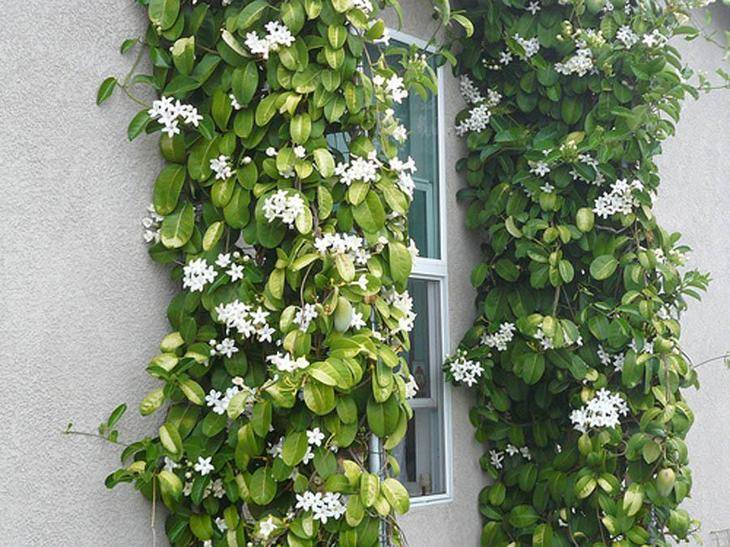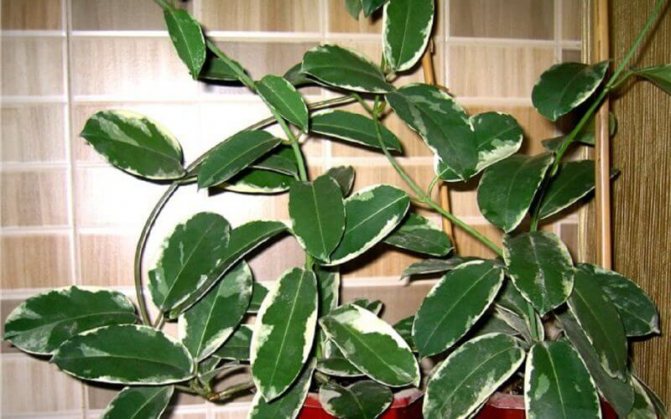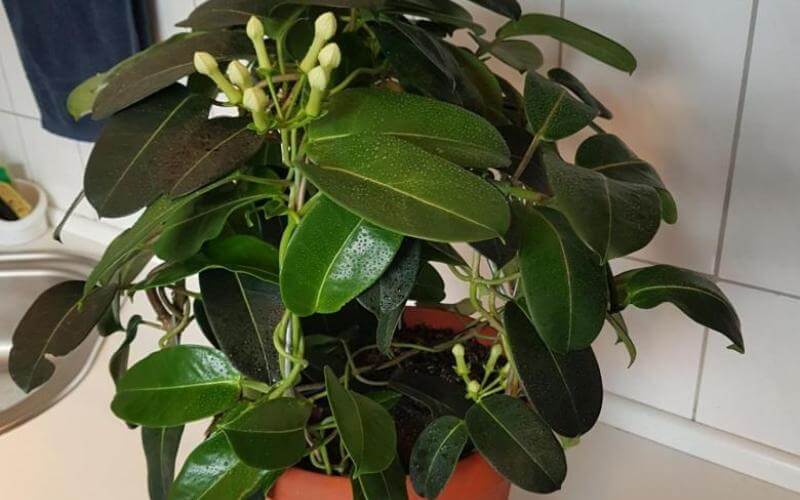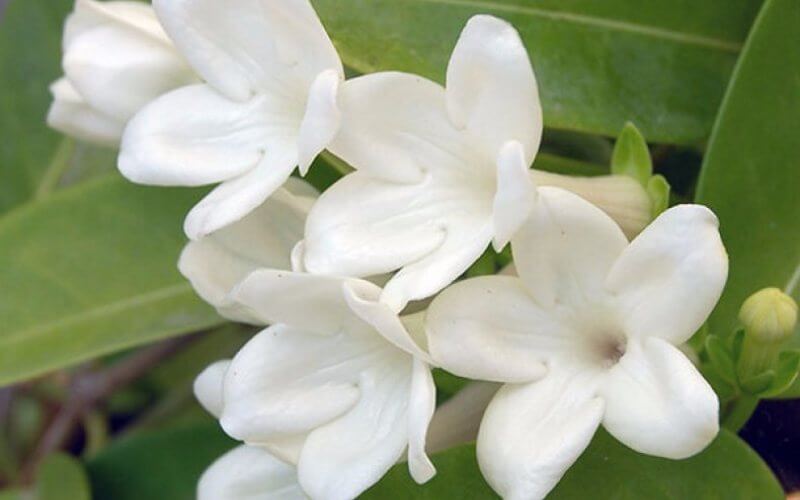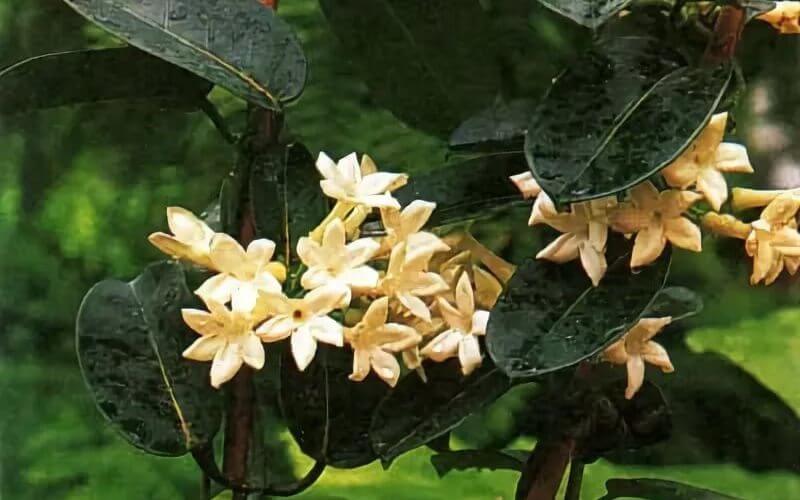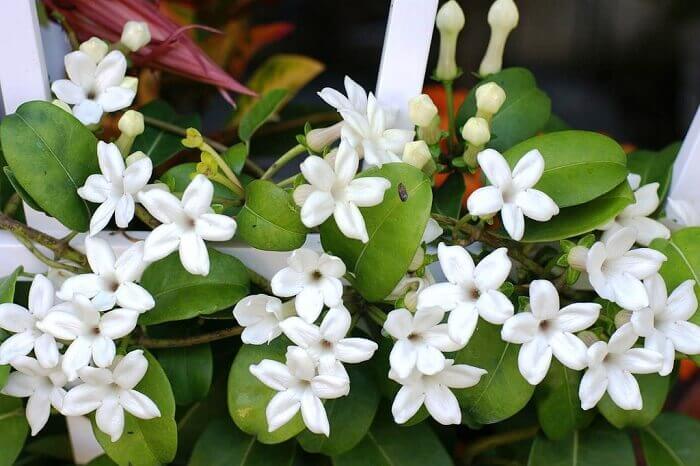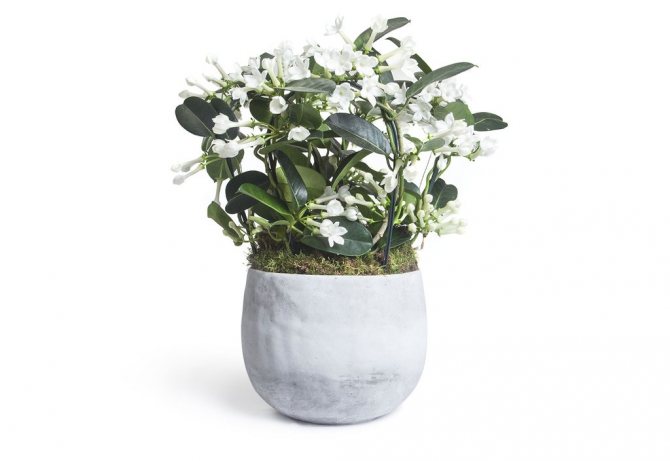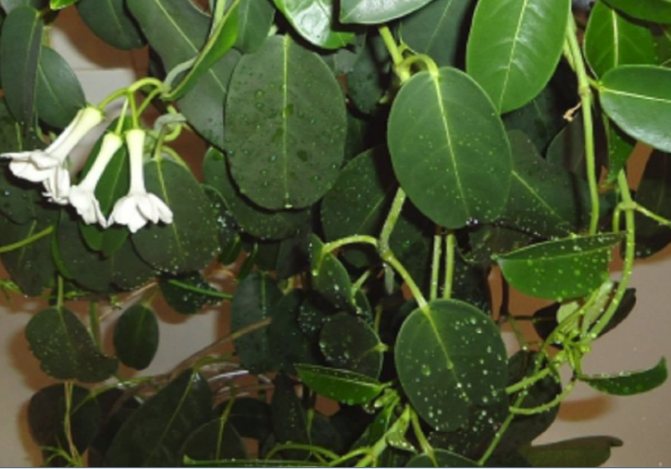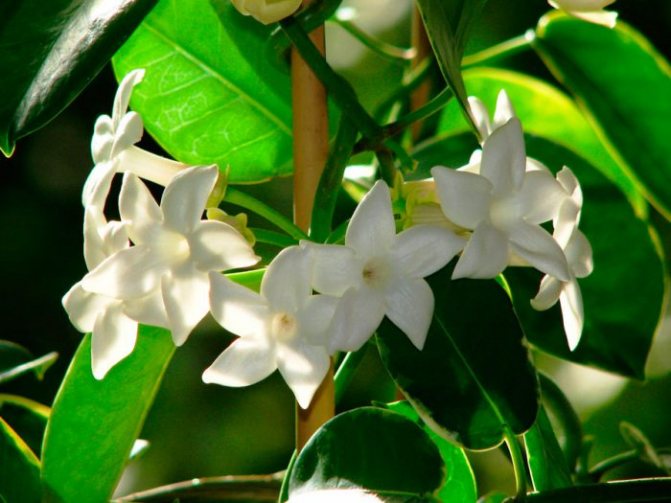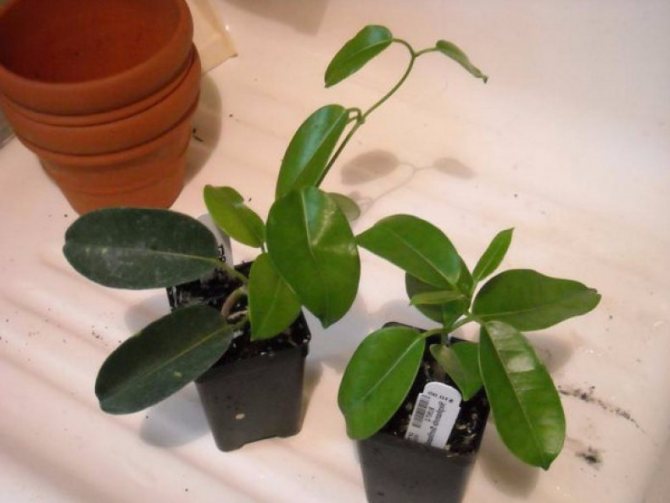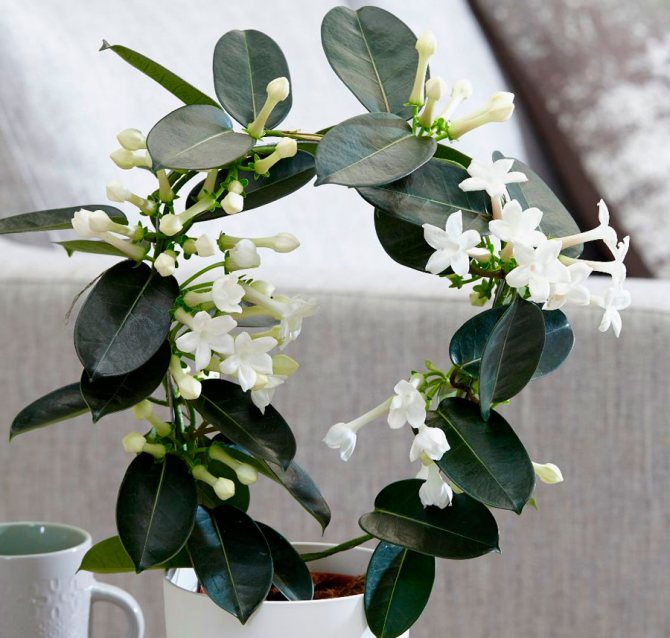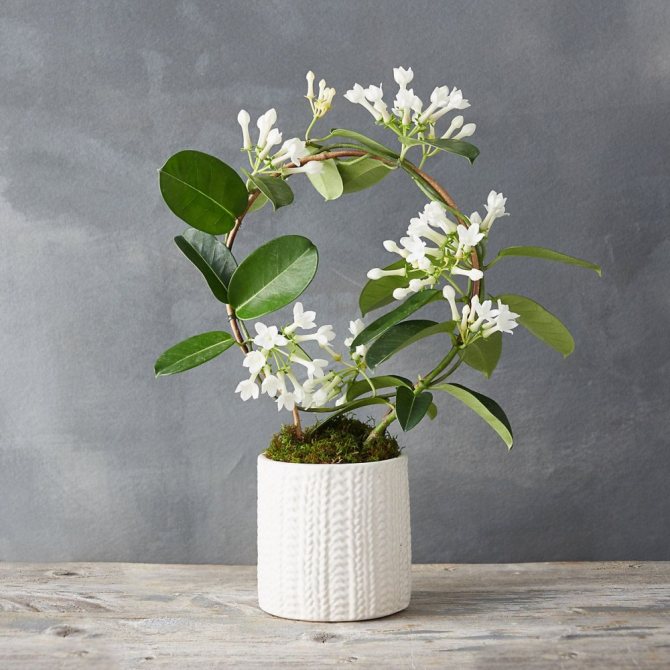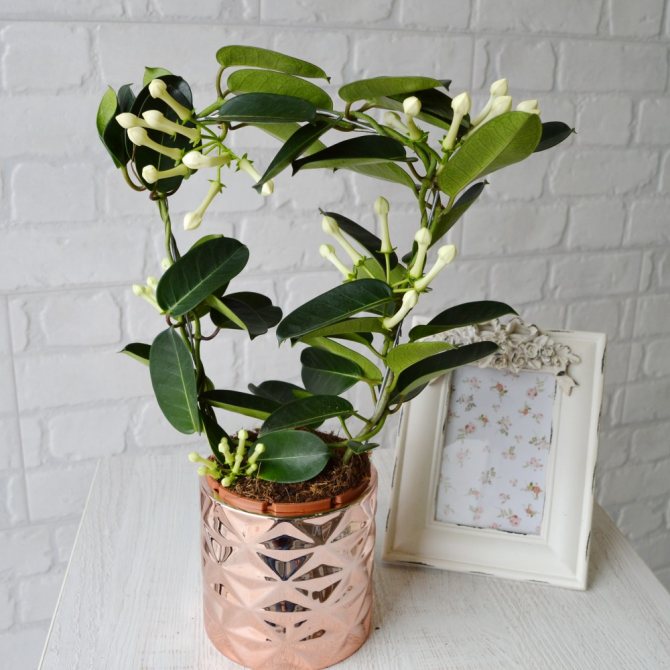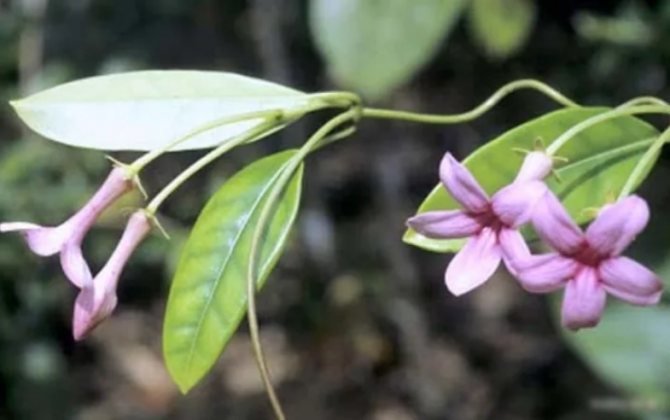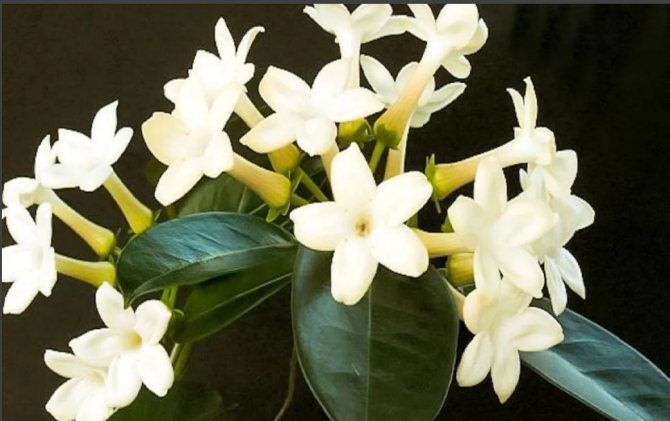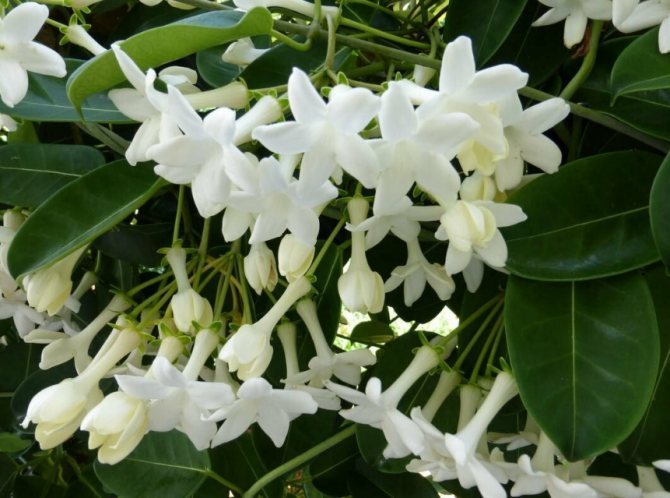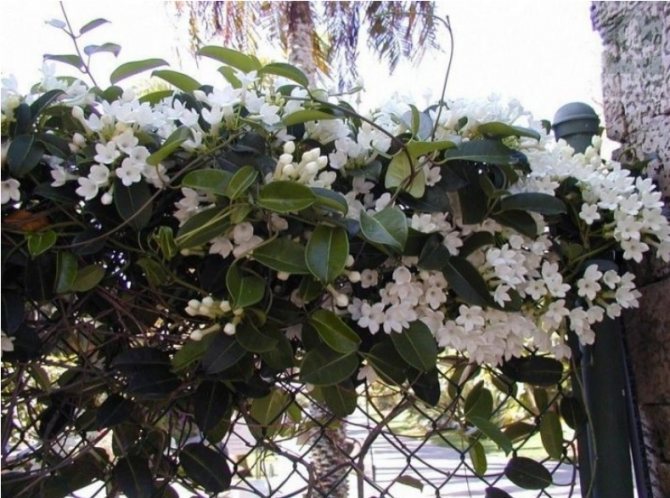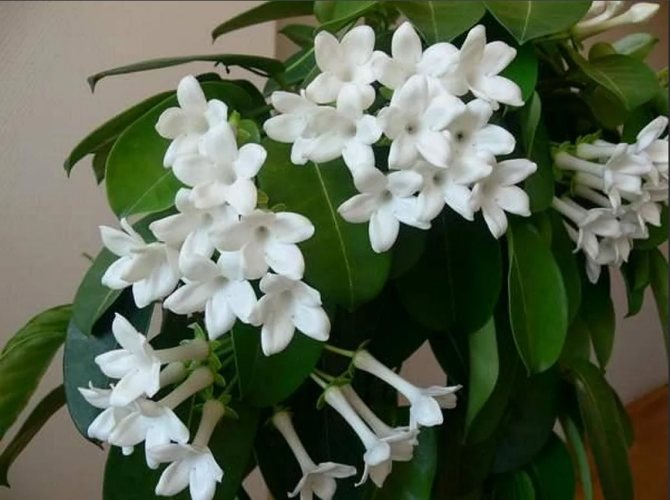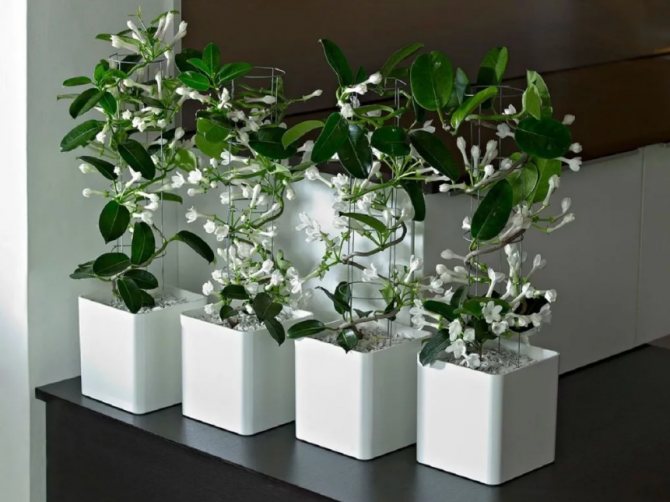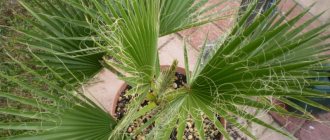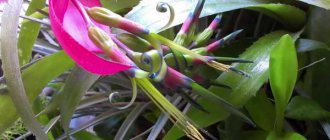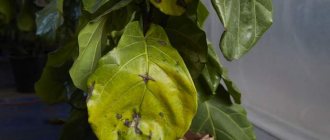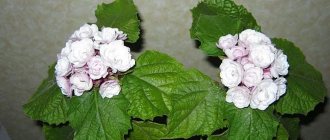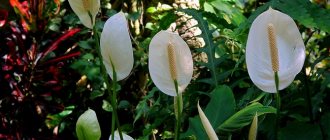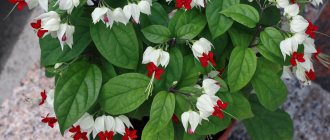Stefanotis is an evergreen vine belonging to the Lastovne family. In its natural environment, it lives in Madagascar, Malaysia, China, Japan. Stephanotis is also called Marsdenia and Madagascar jasmine.
Under natural conditions, only 12 species grow, as only Stephanotis floribunda, aka Stephanotis floribunda, is grown as a houseplant. This vine can grow up to 6 m long. Curly stems are abundantly covered with glossy dark green leaves. The flowering is the most delicate: snow-white flowers are collected in bunches, five-petal corollas reach a diameter of about 5 cm, they exude a pleasant aroma. Indoors blooms from spring to late October.
Liana easily braids various supports. Stefanotis will effectively decorate windows, walls, winter gardens. Her flowers are often used in wedding bouquets.
Please note: contact with plant sap can cause allergic reactions. Always wear gloves when transplanting and breeding.
Description
Perennial climbing vine Stefantis belongs to the Lastonev family, grows up to 6 m.
Characteristic features of a flower:
- The stalk is flexible and resilient in a young plant, stiffens over time.
- The leaves are large, up to 12 cm, are oval in shape with a sharp tip and a bright vein in the center. Smooth, leathery, emerald green or variegated leaves are very attractive, with long cuttings.
- Flowers - have five petals, outwardly resemble a star, collected in a brush. Whether white, purple or yellow, they exude a delicious scent.
- The fruits do not appear often, even in nature, they look like a two-part box with seeds, which opens after ripening and seeds fly out of it like miniature parachutes.
Origin and appearance of Stephanotis
The main place of origin of Stephanotis is the island of Madagascar. It was first discovered in 1806 and immediately received a second name - Madagascar jasmine.

Growing conditions of Stephanotis - rainforests of the island of Madagascar
However, there is evidence that today it is found in natural conditions on the Pacific Islands, Central Asia and Cuba. Stephanotis is a thermophilic vine characteristic of tropical latitudes... In natural conditions, in open ground, the initially herbaceous shoots become lignified over time and reach up to 6 meters in length, densely braiding tree trunks, fences and houses.
Photo Gallery: Outdoor Madagascar Jasmine


Liana stefanotis braiding a tree trunk


Madagascar jasmine is grown as a hedge in the southern latitudes


Stefanotis is widely used in the creation of exteriors
In total, there are 15 species of stephanotis. However, in artificial conditions, they contain only profusely flowering Stephanotis (Stephanotis floribunda), since this is the only species that tolerates home maintenance well - the biology of a plant that is accustomed to warm and humid conditions of a tropical forest makes itself felt.
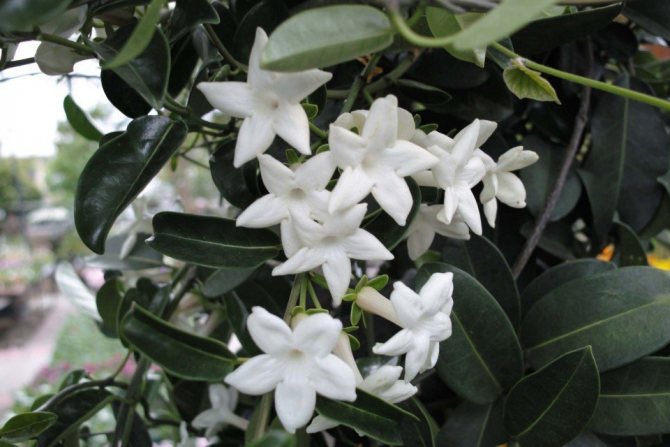

Stefanotis flowering has adapted to indoor cultivation
In addition to the profusely flowering Stephanotis, three more of its species are described in sufficient detail.This is Stephanotis acuminata with cream-colored flowers, Stephanotis grandiflora, with large flowers up to three dozen in one inflorescence and a greenish tint of the bud tube, as well as a very beautiful Stephanotis thorcia (Stephanotis thouarsii) , and the pharynx of the flower is pinkish. However, these types of stephanotis are rarely found in the collection of florists.
Views in the table
The most popular types for indoor growing:
| Name | Features of the |
| Floribunda (profusely flowering). | White flowers, up to 6 cm in diameter, resemble stars in shape. |
| Variegata or variegated. | It differs in the color of the leaves - it has stripes and white, yellow or green spots. The leaves are slightly rounded. |
| Akuminata. | Has flowers of a cream shade. |
| Grandiflora. | It has a larger inflorescence of 30 flowers than other species. |
| Thorsii. | It has a larger inflorescence of 30 flowers, pinkish than other species. |
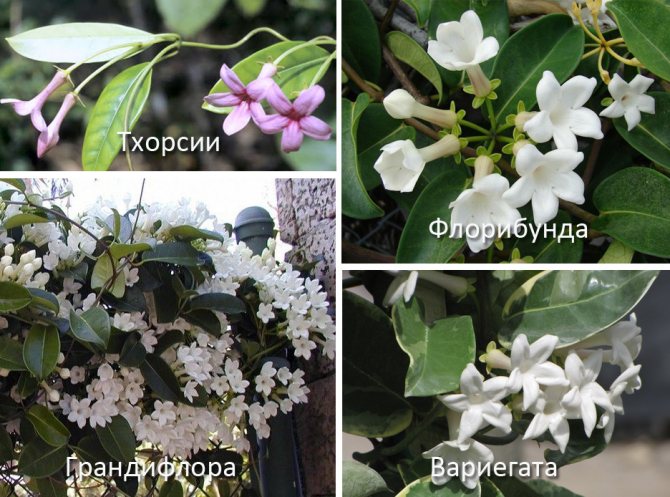

Varieties and varieties


In natural conditions, there are about 16 species of Stephanotis. Only a few of them are suitable for growing at home:
- Abundantly flowering.
- Variegated.
- Grandiflora.
- Akuminata.
Of all the species existing in nature, only one can be found in culture - Stephanotis floribunda (profusely flowering) - a 5-meter liana with wrapped petals that look like a crown. The color of the flowers is white, but there are also cream ones. Up to 7 buds can be located on one branch. Oval dark green leaves can be as large as a human palm.
Stefanotis floribunda variegata is a variation of the above species. Its distinctive feature is the color of the foliage, which is dotted with whitish, light green, yellow stripes and spots, while the tips of the leaves are slightly smoothed.
S. Flibunda Variegata Stefanotis Flibunda
Basic rules of care - tables
It is not easy to care for this tropical plant in an apartment; it will take a lot of time and attention. For the flower to be comfortable in all seasons and for its normal development, conditions are needed, similar to its native tropics.
| Parameters | Requirements |
| Location and lighting | Any direction. On the south, shading is necessary. On the north side there is artificial lighting. |
| Temperature | In summer - from +18 to +24 C, in winter - from +14 to + 16C. |
| Watering | In winter - 1 time in 7 days, in summer - 1 time in 3 days. Eliminate stagnant water and waterlogging of the soil. |
| Humidity | Humid air is preferred or a humidifier should be used. |
| The soil | Preferably clay-sod and deciduous soil, sand, humus. The optimum acidity level is from 5.5 to 6.5 ph. |
| Transfer | Enough once every 2 years. |
| Top dressing | Fertilizers with potassium content. |
| Reproduction | Perhaps cuttings or seeds. |
Lighting, temperature, watering and humidity - by seasons
To make the flower comfortable, you need to create the following conditions:
| Season | Lighting | Humidity | Temperature |
| Spring Summer | Provide diffused light. Place on the southwest or southeast window. | The plant needs moisture. The spraying procedure must be carried out every day, excluding the ingress of water drops on it. Additionally apply a humidifier or place a damp filler on a pallet. | The ideal temperature is from + 18C to + 24C, without sudden changes. It is necessary to ventilate the room where the flower grows every day. |
| Autumn winter | May be south-facing without window shading. Apply additional illumination to provide light for 12 or more hours. | Spraying with warm water is required during the heating season. The hotter it is in the room, the more often it is. It is advisable to wipe the leaves with a damp cloth. Do not use polish. | The ideal temperature in the room is from + 14C to + 16C, but not less than + 13C. The cool content is good for the budding of flower buds. |
Pot, soil, transplant, support
For planting and transplanting a plant, you must adhere to the following recommendations:
Pot
For adult vines, the capacity must be selected especially.
Ceramic pots with a drainage hole are preferred, capable of holding a massive tropical flower, possibly flowerpots.
The size should not be much larger than the volume of the root system.
The soil
In the container where Stefanotis grows, drainage is needed with a layer of at least 3 cm.
Soil composition:
- peat or humus (3/7);
- sand (2/7); deciduous land (1/7);
- clay-sod land (1/7).
This mixture must be disinfected before use.
Transfer
You need to transplant a young, fast-growing liana twice a year. An adult flower - no more than twice every three years. The roots that appear from the drainage hole serve as a signal for transplanting if the substrate begins to dry out faster than before. It is better to transplant from February to the beginning of the growing season.
The flower is transplanted using the transfer method to maintain the integrity of the roots that absorb moisture.
The main stages of the process:
- Put drainage on the bottom of the container, cover with soil mixture.
- Transfer the vine carefully to a new container. If the roots are damaged, add a root growth stimulant to the irrigation water.
- Pour the soil into the pot with the plant and water. You need to wait until the excess liquid drains into the pan, then drain.
Important: You should not transplant the vine during its flowering period.
Support
Curly and growing at a fast pace, stephanotis must have support. In its natural environment, this vine twists around a nearby object or plant.
To support the stem, an arch-like structure is most often used, which can be made from strong wire. The wire must be bent like an arc and placed in the pot. You can build other structures or purchase ready-made ones from plastic.
Top dressing
Stefanotis should be fed once every two weeks, especially during bud setting (April to May). Complex fertilizers with a high percentage of potassium are recommended.
Fertilizers with nitrogen are bad for flowering.
Stephanotis flower: how to find new arrows
This plant differs in that its umbellate inflorescences grow directly from the leaf axils without an arrow. And such inflorescences, as a rule, grow in the amount of 8-11 pcs.
Lack of flowering
Neomarika walking iris: home care and examples of popular varieties
The main value of Stephanotis, as an ornamental plant, is considered to be the snow-white flowers that adorn the liana. But it happens that there is no flowering, and this upsets the grower. The main reasons why Stephanotis does not bloom:
- depleted soil in a pot, due to non-observance of the rules for applying top dressing;
- excessive amount of nitrogen in fertilizers;
- during the wintering period of the plant, the indoor temperature was below 16 ° C;
- the plant is deficient in lighting.
How to make stephanotis bloom
At home, flowering occurs in early summer and lasts about four months. Flowers appear only on adult plants that are 3-4 years old. Compliance with the basic rules of care contributes to annual and abundant flowering:
- timely plant transplant;
- the sequence of top dressing;
- protecting the flower from temperature fluctuations and drafts;
- ensuring correct wintering with an air temperature not exceeding 16 ° С;
- providing adequate lighting. If there is a shortage of it, use additional light sources.
Stefanotis is easy to grow at home.
Note! This flower will delight you with beautiful green leaves and snow-white flowers with a wonderful aroma, you just have to surround it with attention and care, as well as provide proper care.
Flower and fruit
The flowering period of indoor stephanotis is summer or early autumn. Flowers in inflorescences about 10 pieces.Madagascar jasmine is a monoecious plant. Artificial pollination should be done with a thin artistic brush, transferring pollen from the stamens of some flowers to the pistils of others.
Important: Do not put a blooming vine in a bedroom or children's room, as long-term inhalation of its scent can cause migraines and discomfort.
Stefanotis fruits ripen for 9 months. The berries can reach 10 cm, at first they are green, then they turn yellow and wrinkle. After the seeds ripen, the fruit bursts and seeds fly out of it. Each fruit has an average of 100 seeds. Each seed has a fluffy parachute with which it can fly away in the wind for a long distance. To preserve the seeds before ripening, a nylon bag must be put on the fruit.
How to care for a plant
In order for the flower to develop well, it is necessary to create minimum comfortable conditions for it.
Stefanotis floribunda does not like bright light; from direct sunlight, the flower can wither. The best place for him, on the window in which the sun hits only in the evening at sunset. But to remain completely without sunlight is just as harmful for this flower. And in winter it needs lighting. For this, ordinary fluorescent lamps, located not far from the flower itself, are suitable. If this condition is met, your flower will safely survive the winter and in the summer it is quite possible it will bloom.


Room temperature is perfect for Stephanotis, but you should avoid temperature drops and drafts. In winter, you can lower the temperature slightly, but do not freeze the flower.
Watering is not necessary often, but with sufficient water. The soil between waterings should have time to dry out slightly. It should not be very wet, but very dry too. Particular attention should be paid to the moisture content of the plant in winter.
As for the choice of a pot for this flower, then it is worth choosing a smaller pot, since it grows better in cramped conditions. Do a flower transplant when the soil in the pot is dry enough.
In spring the plant should be pruned a little to improve its growth.
Reproduction
Stefanotis can be propagated in several ways:
- seeds;
- cuttings.
Seeds
- Soak the seeds for two days.
- Prepare a container and soil for sowing. A sterilized mixture of peat and sand (50/50) is suitable as a soil.
- Fill the container with soil and moisten before sowing.
- Press the seeds into the prepared substrate.
- Cover the container with a glass jar and place in the light. The temperature should be + 26C on average.
- After drying, moisten the soil with a spray bottle without overmoistening. Remove accumulated condensation from the glass with a napkin.
The seeds will germinate in about 2 months. After the appearance of young foliage, it is necessary to transplant the shoots into small containers with the mixture.
Important: With a short daylight hours, young sprouts need illumination.
Cuttings
The flower is very difficult to root without the use of phytohormones. Rooting is best done in the spring and summer season. The main stages of the process:
- Prepare cuttings - slightly lignified, with 2 leaves. The cut should be made 2 cm below the knot and processed with Kornevin.
- Stick the prepared cuttings into a container with sand, deepening by 1.5 cm, cover with glass.
- Rooting is carried out with bottom heating and timely moistening, it takes about 3 weeks.
- After rooting of the cuttings and the appearance of leaves and fresh shoots, the sprouts should be transplanted into containers up to 9 cm high.Place in a lighted place where the temperature is + 18C on average. The permissible temperature at night is up to + 14C.
- The grown rooted plants need to be planted in larger pots.
Stefanotis decoration
As you know, stephanotis is an ampelous (that is, a climbing plant), but, according to the observations of botanists, stephanotis grows well and develops only if its shoots are located on a vertical support. When hanging, the stems of stefanotis usually turn yellow and become ill.This feature is associated with the natural growth factors of the plant: in its native forests, Stephanotis easily finds a tall and strong neighbor, along which it quickly crawls upward, almost completely braiding it.
The main task of the grower growing Stephanotis is to create conditions as close as possible to natural ones. Therefore, Stephanotis, as a pet, needs to be given a "shoulder" in the form of a massive vertical support. The best solution would be a three-dimensional support or a strong wire frame, curved to your liking: an eight, a triangle, a half ring.
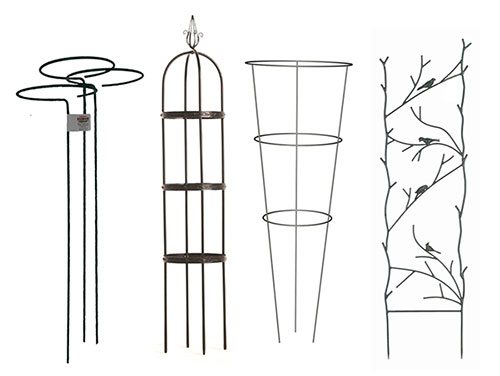

The support is installed in a container with a vine, dropping it to a considerable depth for stability, and then carefully wrapped around with shoots. When stephanotis grows up and the height of the support is not enough, you can braid the branches along the second and even third circle.
With the help of various supports, you can create a magnificent floral arrangement, especially effective during the flowering period.
Care errors, diseases and pests - table
Due to improper care, Stefanotis loses its attractiveness and stops blooming.
| Error | Manifestation | How to eliminate, prevention |
| - Drafts, a sharp drop in temperature. | Leaves are falling. | Place the flower away from drafts at an optimal temperature. |
| - Little light. - Hard irrigation water. - High air temperature. | Leaves turn yellow and fall. | - Put the flower in the light. - Sprinkle with water that has settled for at least 24 hours. - If it's hot, increase the humidity. |
| - Too much nitrogen. - Not enough light. - The plant is resting. | Does not bloom. | - Do not overfeed with nitrogen. - Apply phytolamps. - Place in a cool place during dormancy. |
| Lack of nutrition. | Growth slowed down or stopped. | Fertilizing the flower, especially during the growing season. |
| - Drafts. - Lack of watering. - Change of place. | The buds are falling. | - Avoid drafts, drying out of the soil, maintain moderate humidity. - Do not twist or transfer during the flowering period. |
Improper care weakens the flower, making it more susceptible to diseases and pests.
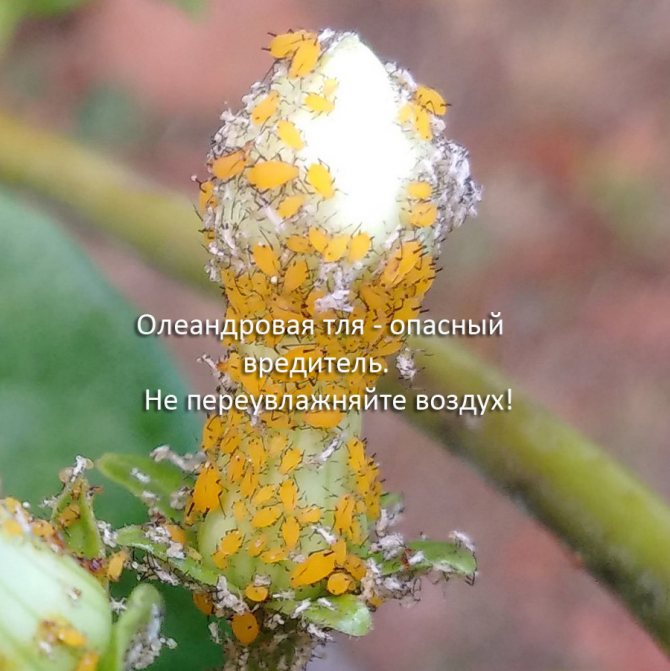

| Pests and diseases | Manifestation | Treatment | Prophylaxis |
| Root and stem base rots. | Roots, stem darken, decompose. | The disease at an early stage is cured by transplanting a flower into a completely replaced substrate with the removal of rotten roots, treatment with Fundazol. | - Compliance with watering regimes. - Disinfection of the soil. - Prevention of drafts and temperature changes. |
| Powdery mildew | At an early stage - a white powdery coating on the leaves. Gradually, the leaves are covered with spots on all sides, interfering with normal photosynthesis. As a result, they dry up. Then the flower dies. | Pluck off affected leaves. Treat the plant with a special preparation, for example, Fundazol. Do not spray the leaves during the treatment period. For prevention or at the onset of the disease, you can treat with a solution of potassium permanganate - 2.5 g per 10 liters of water. Only 3 sprays once every few days. | - Observe the watering regime. - Place the flower in a sunny place. |
| Mushroom gnat | The danger is posed by insect larvae feeding on young flower roots. | You can fight by spraying a Raptor near the flower. A fly eater is used against mosquito larvae. For the drug to take effect, you should not water the soil for 5 days. | - Prevent soil acidification, follow the rules and schedule of watering. - Trap insects with sticky traps or scare off with the smell of citrus. |
| Aphid | Sugar bloom on the leaves, then they deform and die off. | Special preparations are used against these insects: Aktara, Actellik, Decis. Treat the flower with the drug, repeat after 7 days. It is recommended to use different products in turn. In case of severe damage, repeat the procedure 3 times.At the first sign, it is enough to wash the leaves with warm water. An excellent result is obtained by processing with soapy water. | Maintain an optimal level of humidity in the air where the flower grows, since aphids are present in waterlogged air. |
| Shield | It feeds on flower sap. As a result, the leaves turn yellow and fall, the flower itself dies. | Treat the plant with drugs, for example, Fitoverm, several times. Processing is carried out once a week until the final disposal of the pest. The plant affected by the scabbard must be immediately placed separately from the rest. Wipe the leaves with a solution of laundry soap or a weak solution of vinegar essence. | After getting rid of the insect, check the plant from time to time for its presence, because it may reappear. |


Diseases
- If Stephanotis's buds wither and fall off, you either did not protect him from the draft, or you did not add water when watering.
- What to do if the leaves turn yellow? The yellowing of the leaves has several reasons. This may be due to a lack of light, too hard water, or a low temperature. The lack of drainage in the pot, stagnant moisture, and lack of nutrients also negatively affect.
- Why doesn't stephanotis bloom and what to do in this case? The plant does not want to bloom for the following reasons: the flower does not receive enough nutrition or light. And do not forget to provide the liana with a comfortable wintering!
Noticing that Stephanotis decided to release the buds - do not move it to another place. During the budding period, the plant is especially vulnerable and will refuse to bloom if disturbed.
Stephanotis flowers smell great, but prolonged inhalation of the scent can provoke a headache, dizziness and nausea, so it is better to take the flowering plant out of the bedroom at night.
Signs
Some signs, superstitions and myths are associated with almost every houseplant. It is believed that, getting into the house, it spreads its energy around. There are also beliefs regarding the Stefanotis flower. According to one of them, this plant protects the woman's house from men (for example, protecting the bride). The other, on the contrary, says that for good care, it will attract a soul mate to the life of the hostess or harmonize existing relationships. And its flowering, which happens extremely rarely, will be a good omen for this. It was not for nothing that it was called “the flower of the bride”.
You should not pay special attention to myths and omens around the flower, especially those so contradictory. You just need to remember that this plant with a stunning aroma and exotic look has poisonous juice. This does not affect the household in any way if the poison does not enter the body.
It is necessary to keep Stefanotis out of the reach of children and animals and work with him with gloves.
Stefanotis at home - signs of muzhegons
Stephanotis is considered one of the muzhegon plants. These are flowers that patronize women, help them in solving problems, preserving and increasing beauty, youth and all feminine qualities and character traits. But in return for such a benefit, they weaken the male energy, which leads to poor health in men. As a result, they prefer not to even come to a room in which they feel bad. It is possible to keep such plants in the house, but not in every room. Incorrect placement can lead not only to a bad mood for your loved one, but even to rupture of relations or divorce, scandals in the family. Therefore, you should not put it in the matrimonial bedroom and the room of any man, in principle - a son, brother, father.
The best place for muzhegon plants is where the woman spends the most time. For example, a kitchen or a personal desk. By the way, in the office, with the help of stephanotis, you can distract from yourself those with whom you would like to reduce communication. For example, a boss, but this will only work if he is a man.However, signs about whether it is possible to keep stephanotis in the house also have exactly the opposite meaning.
Jasmine - aromatherapy, magical properties
Jasmine is used in magical rites. In the pantry, a real witch should have jasmine, like other aromatic herbs. Jasmine attracts pure love. To attract this kind of love into your life, fill your pads with jasmine and add jasmine flowers to your bathing water.
IMPORTANT: Please note that the chubushnik that grows in Russia is mistakenly called jasmine. Also not jasmine and stephanotis, which is grown as a houseplant. Chubushnik has a pleasant aroma, but it is not used either for adding to tea or for magical rites.
The maximum that you can expect to get from plants growing in our latitudes is that the bushes will decorate the courtyard in an original way, and their dried dry flowers will exude a pleasant aroma. If you have real jasmine flowers in your hands, use them for magic.
For this, the correct psychological attitude is important. Don't think about problems that have been in the past or will be in the future. Listen to pleasant music or relaxing videos. Imagine that you are a witch, psychic and see what mere mortals cannot see.



